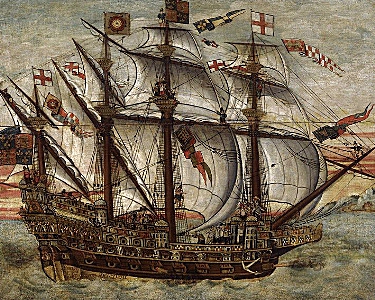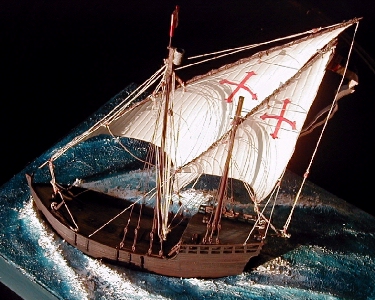
From Wikipedia: a contemporary picture by an anonymous artist, estimated 1575.
Source: Sotheby's sale L09635, Oct. 29, 2009
|

My Heller model of the Niña, that I built around 1985. The water diorama is scratch built of
plaster on cardboard, oil colors and water effect - very simple :)
|
|
Carracks were big oceangoing sailing ships built in the Mediterranian, as a gradual development from
cogs (called "cocha" in the Mediterranian)
and other contemporary ship types. Later, this developement led to the better known
galleons.
The carrack rigging was a gradual development of the one-mast
Square sail
of the Norse and Hansa cogs,
augmented with a
Lateen rigged mizzen mast
and/or a
Square rigged fore mast to make ship steering more stable, because a single square sail
turned out to be difficult to hold course with. And so the carracks became bigger ... carracks were the "big ships" of their era,
also in respect to their rigging:
-
Bowsprit: 1 square spritsail
-
Fore Mast: 2-3 square sails [course, topsail, topgallant sail]
-
Main Mast: 2-3 square sails [course, topsail, topgallant sail]
-
Mizzen Mast: 1-2 lateen mizzen sails only
-
on large carracks: "Bonaventure Mast", a second Mizzen Mast: 1 lateen mizzen only
- no staysails, no stunsails
This rigging was inherited by the galleons later.
Beyond their size up to 50m, they can be disticted from caravels by their tall superstructures, up to 7(!) decks
above the waterline. Warships of that age were the largest carracks of their time, e.g. the "Henri Grace a Dieu".
|
Caravels were small sailing ships in the Mediterranian, or boats, operating before the coasts, also to West Africa.
They were originally as small as fisher boats and transporters.
It is remarkable that these tiny nutshells were used by Columbus to sail to America over the Atlantic,
and even more remarkable, that his smallest caravel, the "Niña" (="girl"),
was the only ship surviving the explorations!
The usual caravel was
Lateen rigged
with 1-3 masts, each carrying 1 lateen sail only, but there was also the
Square Rigged caravel type: the caravela redonda, like the Pinta of Columbus; but even so
the square rigged mast carried only 1 sail.
NOTE: the Caravel ship type and the carvel shipbuilding are closely linked, but maritime research is still disputing
their relation - there is too few historic evidence. It is reported that some caravels sailing to Northern Europe were most distinctive
towards the usual clinker-built Norse ships, in the way how planks were fixed to the hull, which probably led to the word "carvel building"
in Northern European languages.
|
NOTE: languages again ...
In Portuguese, carracks were called caraca or nau,
in Spanish carraca or nao (= "ship"). caravela - where "vela" also means "sail" - was used in both languages.
In French it became caraque, caravelle or nef.
Both ship types were used between 1400 and 1600
Big caravels and small carracks can be hardly distinguished. And to make it more confusing, many of these
ships are also called
galleons. Neither in our modern times nor in the old ages,
there were any clear rules.
Sources and Books
Only little is known about carracks and caravels, the "age of science" was yet to come, so plans are almost non-existent.
We do have many
text sources in the archives about the manifold voyages of hundreds of ships, including the log of the Santa Maria, but
all we get is a few puzzle parts how the ships may have looked like.
There are some rare depictions from contemporary maritime artists; but even when they already applied perspectives
into their paintings, only a few of these artists knew about ships and rigging, the majority did not and made idealized
pictures instead.
Very few books
are dedicated to carracks or caravels - these ships types are explained in dictionary-like books about
ship constructions as a whole through history.
Reconstructions
We have virtually zero information that would be useful to reconstruct these ships on the basis of ancient plans - they were non-existent.
They were built before the "era of science", and shipbuilding was as most things a matter of craftsmanship, and the masters
had all information in their heads ... and keeping that knowledge there was the basis of hierarchy and tradition.
But it is possible - and has been done successfully - to reconstruct the hull and the rigging using the artist´s depictions
that survived from that era, in books and paintings. Some were iconographs on sea charts. So it is possible to prodce a quite detailed
model of it, although 90% is sophisticated reconstruction.
The deck layout is already a matter of 100% speculation, as we lack depictions,
and of course, we no absolutely nothing about belayings,
wether knights, kevels or pin rails were used or not, or how.
If I was to build a full rigged model of a carrack, I would use an early galleon as a pattern to reconstruct the deck layout and belayings.
|

